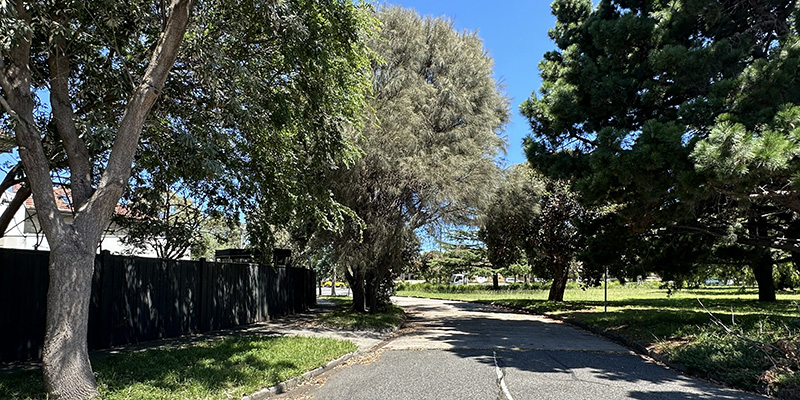Derham Street
Frederick Thomas Derham was born in Somerset, England, in 1844 and arrived in Melbourne with his family in 1856. Derham’s first business undertaking was as a mercantile broker with Callender Calwell & Co. In 1864, he married Ada Anderson with whom he had three sons and a daughter. Ada died in 1874.
Derham had met Thomas Swallow, founder of Swallow & Ariell, in the course of business. When Thomas Ariell died in 1877, Derham became Swallow’s partner. In the following year he married Frances, Swallow’s daughter. In the next nine years they had two sons and three daughters. In 1888 he became a joint managing director with Swallow. After Swallow’s death in 1890 he directed and managed the company for the next thirty years.
As well as managing the business, Derham was deeply involved in community and public life. In 1880 he was elected to the Sandridge Council and was mayor between 1881 and 1883. He resigned in August 1883 and was elected as the member for Sandridge in the Legislative Assembly and retained the seat until 1892.1 It was said of Derham that he was ‘a man to do things and get things done’.
Derham was Postmaster-General of Victoria in the Deakin-Gillies government from 1886. He introduced the penny post, parcel post and country telephone services. In 1889 he put in a pneumatic tube for distributing letters and telegrams between the G.P.O. and the new Stock Exchange building in Melbourne. He resigned from his position in August 1890 when Swallow died, citing the pressure of business, though he continued to represent Port Melbourne until 1892.
Michael Cannon thinks it was more likely that Derham resigned as his extensive property and financial dealings began to unravel as the 1880s boom turned to bust. He had used his role and position, along with other ministers in the government, to borrow heavily and invest in land speculation. Cannon devotes a whole chapter to Derham in The Land Boomers, untangling the complex web of his financial affairs.
Derham was also chairman of the Australian Property Investment Co and while in that position, initiated an ambitious development on the corner of Elizabeth St and Flinders Lane. He paid £65,000 for the site and then borrowed £400,000 for the construction from the London based Home and Colonial Assets Corporation Ltd. The building was planned to be fifteen storeys but when the financial crash came, four storeys were taken off. Nevertheless the Australia Building, as it was known, was the tallest commercial building in Melbourne until 1929. The handsome building was demolished in 19812.
Derham was an active local member. He fronted constituents at lively meetings at the Fountain Inn, Town Hall and at the Cricketers Arms within ‘stinking range’ of the Lagoon – where he was questioned about what he had done, and would do, about resolving the unsanitary state of the Port Melbourne lagoon.
In Port Melbourne, Derham was president of the Port Melbourne Cricket Club from 1892 to 1892 and also president of the Football Club from 1895 to 1897. He was the chairman of the Kindergarten Union, and along with his wife Frances, an active member of Holy Trinity Church. He was ‘always glad to do anything to assist Holy Trinity’. He laid the foundation stone for the church hall in 1886 when he was Post-Master General.
Derham was conservative in politics and represented employer interests. He was founder and first president of the Victorian Employers Union, president of the Victorian Chamber of Manufactures 1897 – 1903 and the Victorian Employers Federation 1901 – 1904. He opposed legislation which established the Victorian Wages Board. There is evidence of his employing under age children between the ages of 10 and 11 in the Swallow & Ariell. He thought compulsory arbitration was a mistaken aim. He was opposed to ‘one man one vote’ legislation.
He suffered a serious illness in 1920 and died in 1922. He had moved to Kew in 1897.
Derham had a long and influential career in business, politics and community life.
Derham St comprises 40 houses, 1 townhouse and 11 units.
For most of the 20th Century Derham St was closely associated with the Port Melbourne Engineering Works and Alfred Harman.
Frederick Thomas Derham: 8 January 1844 – 12 March 1922
MLA for Sandridge 1883 to 18921 (the electorate was renamed Port Melbourne in 1889)
Sources
David Derham Frederick Thomas Derham Australian Dictionary of Biography Vol 4, 1972
Margaret and Graham Bride The Borough and Its People 2013
Michael Cannon The Land Boomers
Terry Keenan In Safe Hands: Presidents of the Port Melbourne Football Club 2011
2Wikipedia contributors. (2021, August 22). APA Building, Melbourne. In Wikipedia, The Free Encyclopedia. Retrieved 11:31, September 2, 2021, from https://en.wikipedia.org/w/index.php?title=APA_Building,_Melbourne&oldid=1040085973
.





